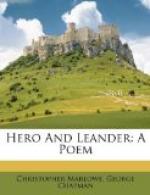|
This section contains 8,072 words (approx. 27 pages at 300 words per page) |

|
SOURCE: Holmes, M. Morgan. “Identity and the Dissidence It Makes: Homoerotic Nonsense in Kit Marlowe's Hero and Leander.” English Studies in Canada 21, no. 2 (June 1995): 151-69.
In the following essay, Holmes examines Marlowe's portrayal of homosexual desire in Hero and Leander.
I
Generations of audiences, readers, and critics have proved that few species of literary dissidence can rival the unsettling force of Marlovian homoerotic desire.1 Christopher Marlowe's homoerotic dissidence ranges from a rather mild, titillating naughtiness—as in “The passionate Sheepheard to his love”—to an outright thwarting of English law and custom—as in Edward II. What unites these two instances across a spectrum of transgressions is an opposition to the definition of individual identity through the discourse of exclusive and immutable sexual desire. Nowhere in Marlowe's oeuvre is such dissidence clearer than in the epyllion Hero and Leander, a homoerotic poem in the tradition of the 1590s...
|
This section contains 8,072 words (approx. 27 pages at 300 words per page) |

|


